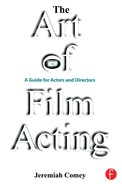0%
28Chapters
0-1Hours read
0kTotal Words
Book Description
This guide for actors and directors develops a valid method for training performers to act from their core--whether they are cold reading, auditioning, or performing for film or television. This book teaches actors how to achieve and respond to believable and honest emotions before the camera, and it maintains that the key to a successful performance lies in how the actors relate to one another and to the circumstances. Exercises, including script examples, throughout the book give readers an easy resource for practicing the principles outlined.The Art of Film Acting applies a classic stage acting method (Stanislavsky) to the more intimate medium of performing before a camera, teaching readers to experience an emotion rather than to indicate it.
Table of Contents
- Cover
- Half Title
- Title Page
- Copyright
- Dedication
- Contents
- Preface
- Acknowledgments
- 1. The Exercise
- 2. Stage versus Film Acting
- 3. Becoming a Great Actor
- 4. Sight Reading
- 5. The Art of Concentration
- 6. The Art of Not Knowing
- Everything Happens As If for the First Time
- Being Intimate without Taking It Personally
- Beginner’s Mind and Logical Mind
- After the Scene, Forget It
- Opinions and Beliefs Will Destroy You
- Play the Character, Not the Stereotype
- Judgment Is a Trap
- Leave Your Feelings on the Set
- Self-Criticism
- Use Your Beginner’s Mind to Not Know
- Summary
- Actor Practice
- 7. More on the Art of Not Knowing
- 8. Still More on the Art of Not Knowing
- 9. The Art of Acceptance
- 10. The Art of Giving and Receiving
- 11. The Senses
- 12. Intimacy, Empathy, and Intuition
- You Are What You Are: The First Ingredient of Intimacy
- Intimacy: The Quality of Good Actors
- Memory and Fear: The Enemies of Intimacy
- Empathy
- Intimacy and Empathy
- Scenes “Not Worthy” of an Actor
- Physical Actions
- Intuition: Your Sixth Sense
- The Creative Inner Child
- Words That Prevent Good Acting
- Act, Don’t Think
- Summary
- Actor Practice
- 13. The Audition
- 14. More on the Audition
- The Casting Director
- The Job
- Acting Is a Business
- Why Actors Don’t Get Cast
- The Differences between the Relating Exercise and the Audition
- The Art of Not Knowing
- The “Where.”
- Sides
- Fear
- Relaxing
- Benefit of the Relating Exercise in Audition
- Skills for the Audition
- Preparation for Audition
- The Audition
- Commercial Improvisation
- Comedic Improvisation
- Dramatic Improvisation
- Summary
- Actor Practice
- 15. The Comedy Audition
- Comedy and Exposition
- Characterization
- Absurd Situations
- Environment
- Comedy Patterns
- Auditioning for Comedy
- Find the Humor
- The Elements of Comedy
- Comic Actors
- Physical Comedy or Farce
- Punching and Undercutting
- Rhythm, Tempo, and Pacing
- Rehearsal
- Emotional Ideas
- Preparing for the Comedy Audition
- In the Audition
- Summary
- Actor Practice
- 16. Conclusion
- Afterword
- Bibliography
- Videography
- Index
